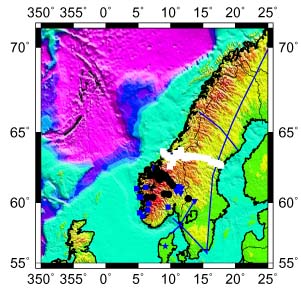Neogene Uplift of Scandinavia - SCANLIPS
 This
is a new project I am working on with Prof Niels Balling at University of
Aarhus in Denmark, Joerg Ebbing at the Norwegian Geological Survey and Chris
Juhlin at University of Uppsala in Sweden.
This
is a new project I am working on with Prof Niels Balling at University of
Aarhus in Denmark, Joerg Ebbing at the Norwegian Geological Survey and Chris
Juhlin at University of Uppsala in Sweden.
About 20 Ma ago Scandinavia rose by c. 2 km, despite being at least 500 km from the mid Atlantic ridge. Such uplift is referred to as epeirogenic uplift - it cannot be explained by conventional plate tectonic theory. Early Paleogene epeirogenic uplift on the UK and adjacent areas is attributed to magmatic underplating. (See work by one of my former PhD students Sulieman Al-Kindi (Kindi et al. 2003)) but this cannot explain the much later uplift of Scandinavia, which is attributed to uplift by the Iceland mantle plume, intraplate stress, Neogene magmatic underplating or Eustatic sea level change. With the exception of Eustatic sea level change these various hypotheses can be tested by using seismic methods to determine the structure of the crust.
In May 2006 we deployed 31 SEIS-UK 6TD seismometers along an East-West profile from the island of Froya off the coast of Norway to Harnosand in Sweden, and along a short North-South line which ties with Niels Balling's existing arrays in southern Norway (see map). The instruments will be in the field until October. We will be using the receiver function and delay time techniques to determine the thickness of the crust beneath Norway and if the data permit the details of the crustal velocity structure. When combined with potential field data this will enable to distinguish between the different hypotheses for the cause of the uplift.
Al-Kindi, S., White, N., Sinha, M.,
England, R. & Tiley, R. 2003. Crustal trace of a hot convective sheet.
Geology, 31, 193-288.
Back to my research page